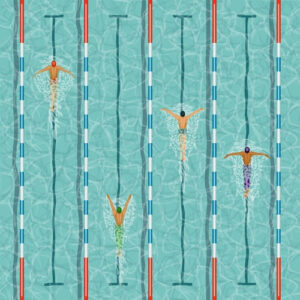In the article “Swimming” we will tell you about the Olympic water sport. You will learn a brief history, types of disciplines and features of the sport.
#Swimming #ProSwimming #SummerSports #AboutSwimming
Swimming originated in ancient times, as people had to swim to find food and avoid starvation. However, as a sport, swimming did not appear until the 1800s in Great Britain and Australia.
In the 19th century, many modern sports were in their infancy, and swimming was no different, but water sports became popular much faster. Immediately, many competitions and championships were held, which further sparked interest in the world of swimming.

Since the sport had enormous popularity, it was only natural for it to be included in the first modern Olympic Games in Athens (1896). At those games the competitions were held in distances of 100, 500 and 1200 meters and without division into styles (swimming was done in any way you could).
Interestingly, at the first Olympics, there was a special swim for sailors. They competed at the 100 m distance, and they had to swim directly in their clothes. The swim took place in the open sea and in the cool water of April. The conditions were, to put it mildly, not the best, so no such races have been held since then.
At the first Games, only men participated in swimming competitions, but women got their right only in 1912 at the 5th Olympics in Stockholm. The world leaders in swimming are such countries as the USA, Australia, Germany and Russia.
The first Olympic medals were brought to our country by the 1956 games. In Melbourne (Australia) our athletes won two bronzes. That time Kharis Yunichev won gold in the 200 breaststroke and the national team won bronze in the 4*100m freestyle relay.

Such names as Alexander Popov, Vladimir Salnikov and current Olympic champion Evgeny Rylov are known to all fans of the sport. Vladimir Salnikov is a true world record holder in swimming. He holds 20 world records, has been included in the Swimming Hall of Fame and has repeatedly been recognized as the best swimmer in the world.
Alexander Popov dominated swimming in the 90’s and early 2000’s. Now he is actively involved in social activities, building swimming pools and training future swimmers. Alexander was Russia’s last Olympic champion for a long time (25 years) until his streak was interrupted by Evgeny Rylov at the 2020 Games.
At the dawn of modern sports swimming, competitions, including the Olympics, were held in sections of open bodies of water. Often they were not precisely measured, and the distance was stated in yards or meters, which led to confusion.
Since the 1920s, the FINA (International Swimming Federation) decided to swim exclusively in swimming pools. This decision was supported by many athletes, because swimming in open water, even in cool weather, is not so pleasant. Since 2008 open water swimming returned to the Olympic family, but as a separate discipline.
Athlete’s swimming costume of the early 20th century covered almost the entire body, only from the mid-30’s swimmers began to wear swim trunks and shorts. Then silk supplanted artificial materials. Nowadays, only women use suits, while men swim in wetshorts.

Olympic pools must be 50 meters in length and have a width of at least 25 meters. The depth of the pool must be at least 2 meters, and the deeper it will be, the faster the athletes will swim, as the waves will not be reflected from the bottom.
Each pool must have at least 8 swimming lanes with a width of 2.5 meters and equipped with wave breakers (they are also lane dividers). Each lane must have its own starting area, on which special start handles are placed.
When an electronic signal is given (a beep for swimmers), an automatic time synchronization is started. When the athlete touches the touch pad on their lane, the synchronization stops. It is worth noting that no waves or water swirls will allow the touch pad to close.
The quality of the pool water determines the athletic performance. Water in the pool should meet the requirements of drinking water. Just add a couple of packs of salt to the pool, and the results will instantly increase, because the salt water has a higher density, and therefore a stronger “ejection force”.

In the middle of the last century, an American swimmer, wishing to set a new world record, poured about 10 kg of salt into the pool. The next day the technical services discovered the “seasoning”, the record was cancelled, and the athlete was disqualified. Since then, water quality is monitored several times a day.
Each type of competition is divided into several stages: Preliminary Swims, Semifinals, and Finals. In the preliminary heats to identify semi-finalists competition organizers may hold an additional heats between participants who showed the same time and claim the last place passed. The same situation can happen in the semi-finals.
At the first Olympics there were a few odd, in today’s view, disciplines. For example, in 1900 in Paris, athletes swam a distance with obstacles, they had to make their way among logs submerged in water and dive under boats anchored. But the styles of swimming themselves were not particularly varied. Gradually swimming became a more rigorous sport, and new styles, types and disciplines emerged.

Freestyle swimming is a discipline in which the swimmer can swim any way he wants and even change them over the course of the course. Once the most popular style was the breaststroke, but then it was replaced by another style, the crawl, which allowed for better results. The breaststroke is a way of swimming in which the legs and arms move symmetrically, while in the crawl it is done alternately.
In 1900, backstroke became an independent Olympic program. Initially the swimmers preferred to cover the distance in backstroke, so to speak, inverted breaststroke, but then the crawl prevailed there as well.
The breaststroke also became a separate Olympic event, but even here it had to squeeze out its popularity. It had to give way to its own variety, although more speedy, the butterfly.
Butterfly is the most energy consuming type of swimming, but in terms of speed it is second only to the crawl on the chest. When swimming in this style, the swimmer’s legs and torso perform wavy and symmetrical up and down movements.
Swimmers of different weight enter the starting area, and many may think that the heaviest of them will be much more difficult to swim the distance. In fact, that’s not the case. Everyone is on an equal footing, since the pushing force in the water acts on the athletes.

The famous Greek scientist Archimedes first investigated this question and discovered an amazing law. The expulsive force acting on a body immersed in a liquid is equal in magnitude to the force of gravity acting on a liquid of the same volume as the immersed body.
And this “pushing force” is always directed upward. Therefore, if the swimmer is not very large, the pushing force acting on him will be less than the one that pushes an athletically built swimmer out of the water.
If you like swimming, do not limit yourself to compulsory lessons, because the real success can be achieved only in special swimming sections. Such sections work almost in every city and children of all ages participate in them.
Many sections even have groups for children from 1.5 to 6 years. Swimming contributes to the development of the body, improves health, makes us stronger and more enduring, teaches us how to breathe correctly, improving the respiratory system. On the benefits of swimming we have devoted a separate article, which can be found here: “Benefits of swimming“.
Moreover, scientists from Great Britain conducted a study on “The Effect of Sport on Longevity,” and swimming has shown excellent results. You can read about the studies in our article “The most useful sport“.
If you are going to take up swimming seriously, it is worth thinking about your equipment. Do not hurt sports swimming trunks or swimsuit, cap, goggles, and do not forget about the clothes in season.
About swimming
FAQs
What is swimming?
Swimming is a summer sport in which an athlete must swim a certain style of distance in the shortest amount of time. Mainly swimmers use 3 styles: Brass, Butterfly and Kroll. In disciplines with freestyle it is allowed to use any style of swimming or a combination of them.
Why were wetsuits banned in swimming?
Wetsuits were banned because they gave swimmers better buoyancy (kept air and water out) and improved gliding (reduced water resistance). World records were no longer of value because they were not achieved by perfect technique and endurance, but by technology. Currently, men are allowed to go to the start in knee-length wetsuits made of textile material no thicker than 0.8 mm, and for women a textile wetsuit must not cover the neck.
Why are all swimmers tall?
Tall swimmers experience less wave resistance while swimming, which allows them to swim 1.3% faster. Tall swimmers have a longer hand and arm length and this allows them to make a more powerful stroke. Leg length and foot size affect stroke action, water grip area, and energy expenditure. The tallest athletes swim backstroke and the shortest swimmers swim the breaststroke style (height from 170 cm).









